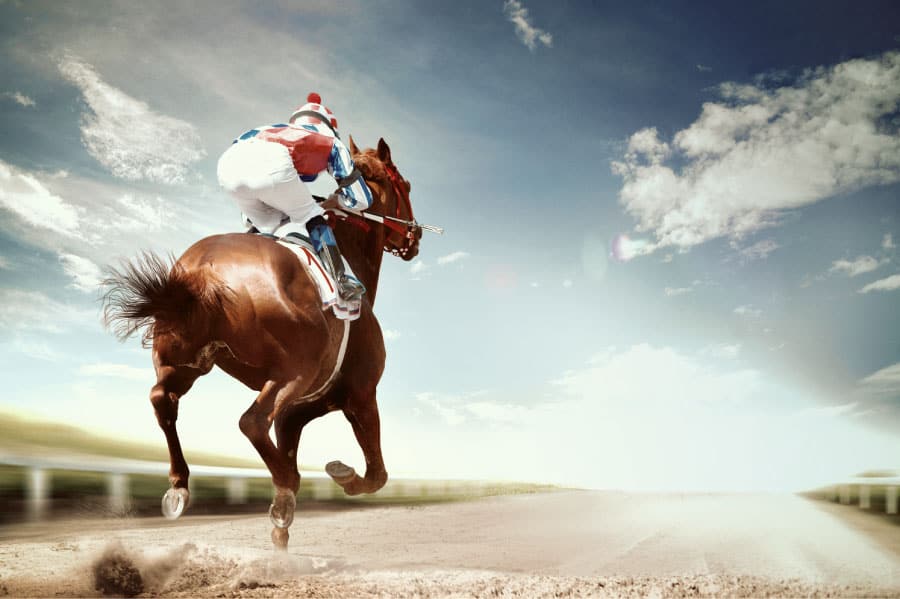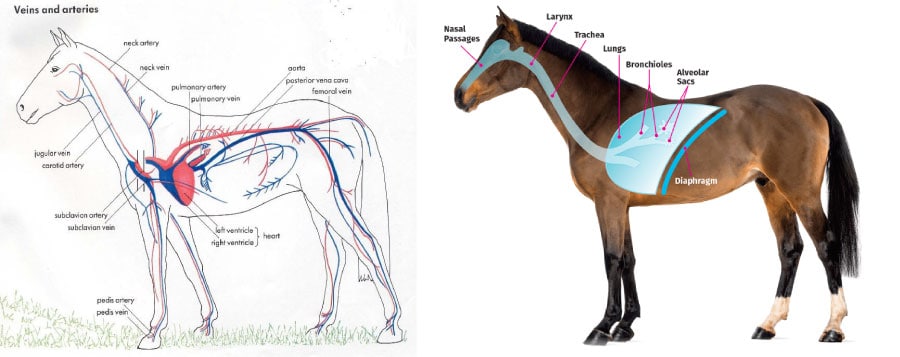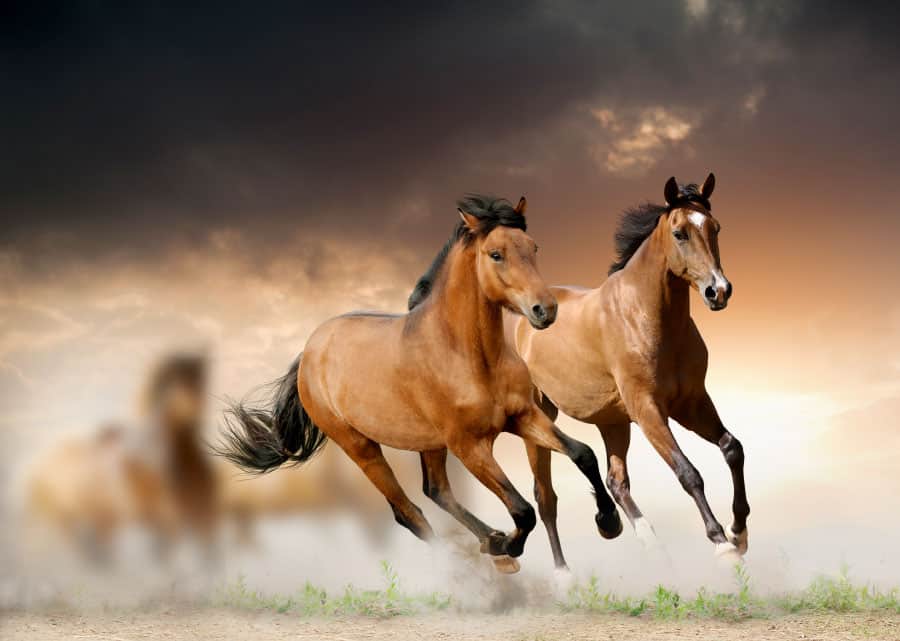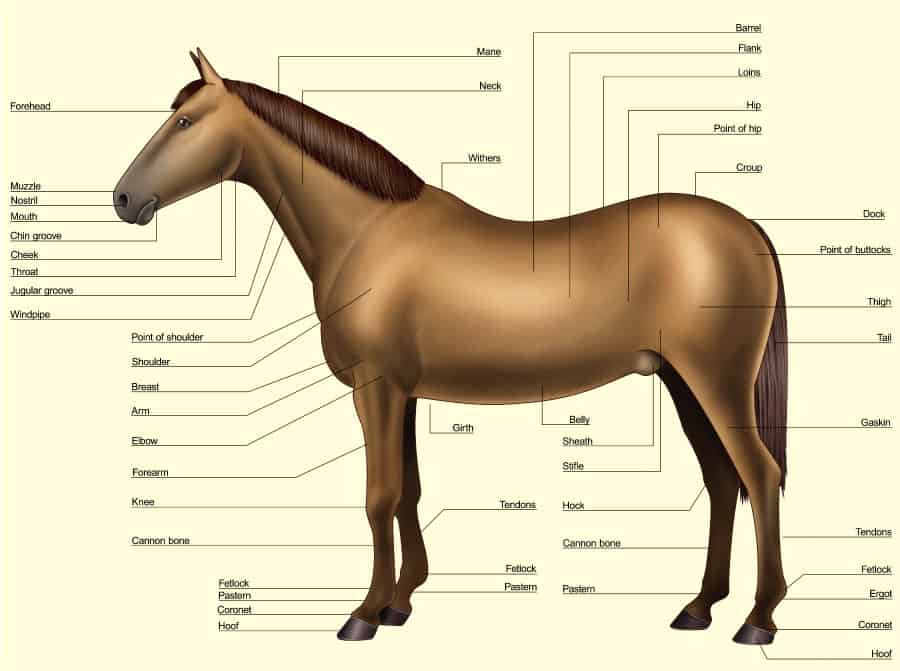- Your source for stall mats, rubber arena footing, arena harrows and arena dust control.

From the many equestrian events and competitions to horse racing events, to enjoying the day out in the natural world on your horse, horses are born run. But have you ever wondered if they could die due to running?
Yes, horses can run themselves to death. While running, horses place their cardiovascular and respiratory systems under a lot of pressure, which could, in some situations, lead to a heart attack, stroke, or respiratory failure, and lead to death.
There’s so much to get into and cover on this topic, though, so read on for an in-depth look at why, how, and what could cause a horse to die from running.
Can Horses Run Themselves To Death?
A horse running itself to death is dependent on the circumstances that the particular horse is in.
For example, a horse in the wild being hunted by a predator, a thoroughbred running at top speed (60km/h) against 10 to 15 other horses with a jockey on its back, an injured horse in a threatening situation, and the list goes on.
Here are a few points to consider regarding whether or not a horse can run itself to death.
On average, a horse’s heart weighs 3 to 4 kilograms, and their lungs take up the majority of the abdominal cavity when inflated. This means that a horse manages to pump 30 to 40 liters of blood per minute and take an average of 8 to 16 breaths per minute.
Therefore you can imagine that at top speed, a thoroughbred’s heart beats at 225 to 240 beats per minute, and it takes 180 breaths per minute. A heart attack, stroke, or respiratory failure, would be detrimental to the horse while running and can lead to death.
For more on this check out our post on how long horse can run .
.
Understanding a horse’s anatomy
Here are some photos of a horse’s cardiovascular and respiratory systems to help you understand the anatomy and function of both systems:

Respiratory tract
If a horse’s respiratory tract is not functioning properly due to illness or physical abnormalities, this leads to an inefficient respiratory system. If a horse with an improperly functioning respiratory tract is forced to run at top speed, it could lead to death due to suffocation, etc.
Here are a few of the illnesses and abnormalities that can affect a horse’s respiratory tract:
- Respiratory tract infections (equine herpes virus and strangles)
- Laryngeal lymphoid hyperplasia (also called pimples)
- Dorsal displacement of the soft palate
- Nasopharyngeal collapse
- Laryngeal hemiplegia (roaring)
- Epiglottic entrapment
- Exercise-induced pulmonary hemorrhage (EIPH)
- Pneumonia
- Pleuritis
- Inflammatory airway disease (IAD).
Cardio vascular system
As athletic as horses are, especially thoroughbreds, unfortunately, they do experience heart attacks due to the severe strain running puts on the cardiovascular system of a horse.
Here are a few illnesses and conditions of the cardiovascular system that can affect the efficacy of a horse’s heart:
- Atrial fibrillation (arrhythmia)
- Heart murmurs
- Sudden Cardia death (fatal cardiac arrhythmia)
- Aortic rupture (rupture of a major blood vessel (aorta))
- Congenital defects (uncommon)
- Illness such as anemia, fever, or toxic compromises the heart
Brief history of horse racing
Let’s have a more in-depth look at the history of horse racing.
Horse racing is an ancient sport that dates back to about 4500 BC among the nomadic tribesmen of Central Asia (who first domesticated the horse). Since then, horse racing has flourished as the sport of kings.
The thoroughbred horse was then developed through very careful and meticulous breeding into the amazing athlete it is today.
Racehorses are good at what they do as they have the desire to win. They seek the competition, their spirit yearns to win and they love to run. This is what makes the thoroughbred so good at what they do, which can often time override their self-preservation instinct.
Breeding Thoroughbred horses for racing
The thoroughbred horse originated in England around the beginning of the 18th century, when the three foundation sires arrived in England. These horses were from the oriental group, which consisted of Arabians, Turks, and Barbs. Those three breeds are native to the Middle East. By breeding with the larger English mares, it formed the thoroughbred horse.
An interesting fact is that all thoroughbred foals can trace their bloodlines back to one of those three foundation sires.
Here are some historical facts on all three foundation sires:
- Byrely Turk arrived in England in 1688. He was captured by Captain Robert Byerley, hence the name, and Byerley admired the horse’s courage in battle.
Fun fact: A horse’s temperament can be passed on to their offspring
- Darley Barb, a four-year-old colt, arrived in England in 1704, several years after Byrely Turk. Thomas Darley, a diplomat to Syria, who had purchased the horse from a Bedouin sheik, eventually stole the horse and had it smuggled to England as the sheik failed to deliver the horse.
- The third and final stallion, the Godolphin Arabian from Yemen, arrived in England sometime after its birth in 1724. The Godolphin Arabian was part of a quartet of Arabians given as a gift to the king of France, who decided to release them. After serving as a cart-horse in Paris, the Godolphin got passed around from owner to owner several times before he was purchased by the Second Earl of Godolphin around 1733.
Characteristics of Thoroughbred horses
Thoroughbreds have two special characteristics that make them so well suited for racing.
- Their long necks move in unison with their front legs, which propels them further forward.
- Secondly, the hind legs in the breed bend and straighten in a nearly vertical line, which produces a spring-like action and propels the horse forward more efficiently with each step than any other breed.
Classification of Thoroughbred colors
An interesting fact about the thoroughbred is that according to the breed registrar known as the Jockey Club, the only colors that a thoroughbred is allowed to be, are:
- Bay – tan with black legs
- Roan – reddish brown
- Chestnut – a red-yellow or red-brown
- Palomino – a golden-yellow horse with blonde mane and tail
The American Jockey Club also accepts the following colours added to the original 5:
- White
- Black
- Gray
- Gray/Roan
- Brown

Flight/prey response in horses
Horses are flight/prey animals. Natural self-preservation is an instinct that is engrained in their DNA, which means they have an acute sense of prey versus predator.
Even as domesticated as they are, certain instincts remain. Anything that a horse has never experienced before activates that self-preservation instinct.
Like a lawn-mower, for example. If not slowly introduced and explained or shown to the horse that this object that makes a very loud noise is not going to eat or kill them, it will result in the horse doing everything in its power to get away from that said object.
Meaning, if there is a barbed-wire fence, a massive ditch, or a fence, the horse will run through it or try to jump over it to get away. They do not have the mental capacity to consider the consequences of going through or over that obstacle, which may injure it, resulting in its death.
Common condition/injuries that occur in horses
Talking about injuries and getting back to the thoroughbred, many suffer catastrophic injures on the track. Almost all of them being the limbs, tendon, ligament, and bone injuries. Almost all of these injuries occur on the track while they are running a race.
Due to the adrenalin as well as that self-preservation instinct a horse can snap its leg clean in half and continue running. It’s quite traumatic for the spectators seeing a horse running at full speed with a limb dangling, but unfortunately, it’s part of the sport and you cannot predict when and how the injuries occur.
The jockey has to then try very hard to get the horse to stop. Once stopped, the horse ambulance arrives on the track, a screen gets put up and the horse is usually shot on the track.
So yes, sometimes horses get shot on the track. The reason being that severe leg injuries on horses do not heal very well, rehabilitation costs a lot of money and most owners would rather spend that on a new horse.
Here are a few injuries that can occur, aside from the limb, in a racehorse (bearing in mind a lot of these injuries can and do also occur in other disciplines):
- The most common catastrophic injuries include fractures of the humerus (the bone located between the shoulder and elbow joints), cannon or third metacarpal bone, and sesamoid bones, with 90% of these injuries occurring in the forelimbs.
- Suspensory ligament injuries
- Deep and superficial flexor tendon injuries
- Knee (carpus) problems–such as carpitis (knee inflammation)
- Chip fractures
- Bucked shins (tiny stress fractures of the cannon bone)
- Bone fatigue (lack of remodeling to strengthen the bones)
- Scapular fractures
- Pelvic fractures
Below are labeled diagrams of the horse’s skeletal system and the ligaments, tendons of the limb, to give you an idea as to where all the injuries are situated.

Conclusion
There is a common theme in this article, which is human intervention and/or interference. If you consider the situation of a horse running to death in the wild due to a heart attack because a predator is chasing it, it makes sense. Yet there is barely any wild horse left, and where the few still exist, they rarely have natural predators.
A horse running in an open field will injure itself because of fencing made by humans.
Horses are forced to run at top speed by humans even if they are no longer physically capable.
The fact remains, horses can run themselves to death. This fact is with or without human interference, but most commonly due to our own doing.
I hope that this article helped you find the answer you were looking for and taught you a bit more about horses.

